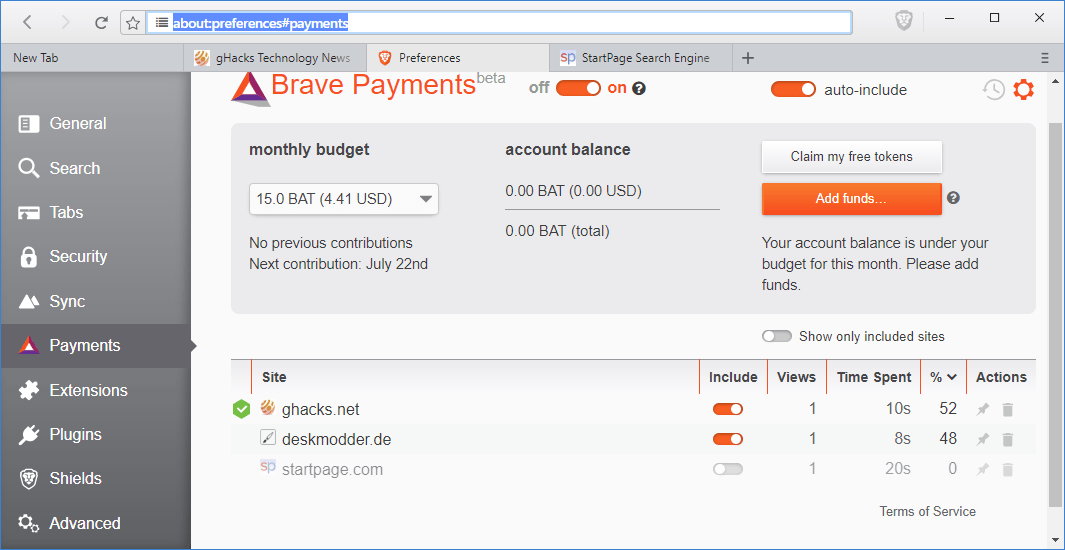Brave starts opt-in Ads trial that rewards users and publishers
Brave, the Chromium-based web browser by former Mozilla CEO Brendan Eich, just entered the next stage of the master plan to change how websites and publishers earn money on the Internet.
One of the key ideas behind Brave was to replace the current advertisement system of the Internet with a better one. Brave wanted to establish its own system that shares the advertisement revenue between publishers, users, and the company.
Brave uses its own currency and platform for that. BAT, Basic Attention Tokens, has been integrated into Brave Payments last year and some users started to use it to distribute BAT to publishers and creators anonymously. Brave funds this currently if you opt-in; this means that you do get a monthly budget of 15 BAT (about 4.41 USD) that you can distribute to websites you visit.

To do that, load about:preferences#payments and use the include toggle to add a site to the distribution pool.
The company announced the start of opt-in advertisement trials yesterday. Users need to leave a comment on the Brave forum and may be selected for the trial when they do.
Brave wants to do things differently in regards to advertisement and the two core difference to the existing advertising model are the following ones:
- Brave pays users about 70% of the gross advertising revenue in BAT. Users can use BAT to reward sites they visit or exchange it for other currency in the future.
- Brave's advertising model values user privacy. Instead of tracking users, it is downloading a set of ads to the user system based on region and language, and displays the most appropriate ad using local matching.
The advertisement option will be opt-in and consent-based according to Brave. Users who don't want to see advertisement don't need to change anything as ads won't be displayed to them.
By moving matching from the ad exchange to the device, Brave ads merge innovation with privacy-by-design and put the user in control. Instead of sending and exposing user data to opaque third parties in cloud-based auctions, Brave’s approach enables a more efficient and direct opportunity to access user attention without the inherent liabilities and risks involved with large scale user data collection.
Brave pushes ad catalogs (one per region and natural language) to available devices on a recurring basis. Downloading a catalog does not identify any user. As the user browses, Brave locally matches the best available ad from the catalog to display that ad at the appropriate time. Brave ads are opt-in and consent-based (disabled by default), and engineered to operate without leaking the user’s personal data from their device.
You can download Brave from the official website.
Closing Words
Brave's success depends on numbers first and foremost in my opinion. I mentioned previously that Ghacks would be self-sufficient if every visitor would pay a few cents monthly and that I would remove all ads immediately in that case. Problem is: most payment types cost money and visitors would have to pay a multiple of the sum they provide for support as fees.
Brave could change that as users can earn the money that they want to give to publishers they like when they browse the Internet. It is also possible to buy BAT and distribute it to all publishers that way.
If Brave reaches a critical threshold it could work (yes I changed my initial stance on Brave).
Now You: What is your take on Brave's approach?
This article was first seen on ComTek's "TekBits" Technology News

- Log in to post comments